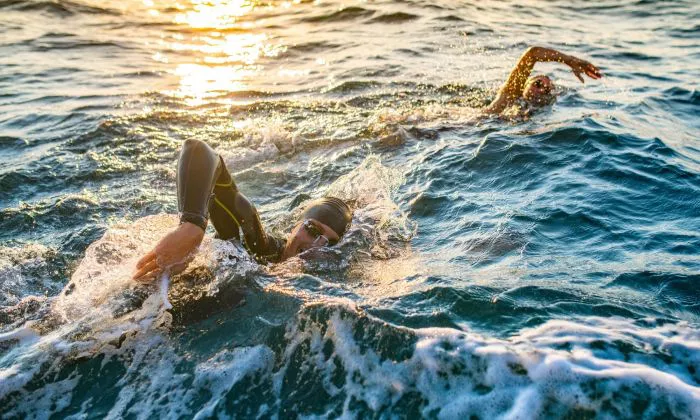Determining the exact number of calories burned during sea swimming can be challenging due to various factors such as individual physiology, swimming technique, water temperature, and intensity of the workout. However, we can estimate the calorie expenditure based on general principles and scientific research. In this essay, we’ll explore the calorie-burning potential of sea swimming, factors influencing calorie expenditure, and how to maximize the benefits of this enjoyable form of exercise.
Calorie Expenditure During Swimming
Swimming is a full-body workout that engages multiple muscle groups and promotes cardiovascular fitness. The number of calories burned during swimming depends on factors such as the swimmer’s weight, swimming speed, stroke technique, and duration of the workout. According to estimates from the American Council on Exercise (ACE), the average person burns approximately 400 to 700 calories per hour of swimming, depending on the intensity of the workout.
Factors Influencing Calorie Expenditure
Several factors influence the calorie expenditure during sea swimming:
Swimming Stroke: Different swimming strokes engage different muscle groups and vary in intensity. For example, the butterfly stroke and freestyle (front crawl) tend to burn more calories compared to the breaststroke or backstroke.
Swimming Speed: Swimming at a faster pace requires more energy expenditure and typically burns more calories per hour compared to swimming at a slower pace.
Water Temperature: Swimming in colder water temperatures may increase calorie expenditure as the body works harder to maintain core temperature. However, prolonged exposure to cold water can also lead to fatigue and may affect overall performance.
Body Composition: Individuals with higher muscle mass tend to burn more calories during swimming as muscle tissue requires more energy at rest compared to fat tissue. Additionally, heavier individuals may burn more calories due to the increased effort required to move through the water.
Swimming Efficiency: Efficient swimming technique, including proper body positioning, streamlined movements, and rhythmic breathing, can improve swimming performance and calorie efficiency. Conversely, poor technique or excessive splashing may increase energy expenditure without necessarily improving performance.
Benefits of Sea Swimming
Sea swimming offers numerous health benefits beyond calorie burning:
Cardiovascular Fitness: Swimming is an excellent cardiovascular exercise that improves heart health, strengthens the heart muscle, and increases circulation. Sea swimming, in particular, may offer additional benefits due to the resistance provided by waves and currents.
Muscle Strength and Endurance: Swimming engages multiple muscle groups, including the core, arms, legs, back, and shoulders. Regular sea swimming can improve muscle strength, endurance, and overall tone, leading to a more sculpted physique.
Low-Impact Exercise: Swimming is a low-impact exercise that is gentle on the joints, making it suitable for individuals with joint pain, arthritis, or mobility issues. Sea swimming provides buoyancy and support, reducing the risk of injury compared to high-impact activities like running or jumping.
Mental Well-Being: Swimming in the sea offers psychological benefits such as stress relief, relaxation, and improved mood. The calming effect of water, combined with the rhythmic motion of swimming, can promote feelings of tranquility and mental clarity.
Tips for Maximizing Calorie Burn
To maximize the calorie-burning potential of sea swimming, consider the following tips:
Interval Training: Incorporate intervals of high-intensity swimming followed by periods of rest or lower intensity. Interval training can increase calorie expenditure and improve cardiovascular fitness more effectively than steady-state swimming.
Variety of Strokes: Experiment with different swimming strokes to engage various muscle groups and prevent boredom. Alternate between freestyle, breaststroke, backstroke, and butterfly to challenge your body in different ways.
Open Water Challenges: Participate in open water swimming events or challenges to increase motivation and push your limits. Swimming in open water environments such as the sea or lakes can provide additional challenges and opportunities for calorie burning.
Proper Nutrition: Fuel your body with a balanced diet rich in lean proteins, complex carbohydrates, and healthy fats to support energy levels and recovery. Stay hydrated before, during, and after swimming to maintain optimal performance and prevent dehydration.
Safety Considerations
Before engaging in sea swimming, it’s essential to prioritize safety and take necessary precautions:
Swim in Designated Areas: Choose swimming locations that are safe and monitored, such as designated swimming beaches or areas with lifeguards on duty.
Check Water Conditions: Be aware of water conditions such as tides, currents, and wave heights before entering the water. Avoid swimming in rough seas or strong currents that may pose risks to safety.
Wear Sun Protection: Protect your skin from sun exposure by wearing sunscreen, a hat, and UV-protective swimwear. Reapply sunscreen regularly, especially after swimming or sweating.
Stay Hydrated: Drink plenty of water before and after swimming to prevent dehydration, particularly in hot weather or during prolonged swimming sessions.
Conclusion
In conclusion, sea swimming is an effective form of exercise that can burn a significant number of calories while offering numerous health benefits. By considering factors such as swimming technique, intensity, and duration, individuals can maximize calorie expenditure and achieve their fitness goals. Additionally, prioritizing safety, proper nutrition, and hydration is essential for enjoying sea swimming safely and responsibly. Whether you’re looking to improve cardiovascular fitness, build muscle strength, or simply enjoy the tranquility of the ocean, sea swimming offers a refreshing and invigorating workout that can be tailored to suit individual preferences and fitness levels.
Related topics:


